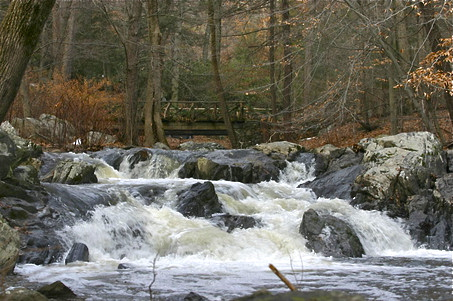Dupont Partial Lake Cleanup Plan Uses Flawed Science to Minimize Problem
Florio Lets Liability Cat Out of the Bag
EPA must stand by Regional Administrator Enck’s commitment and their own science and reject the Dupont proposal.

sun sets on mercury laced Pompton Lake (1/5/12)
Dupont has a big mercury problem in Pompton Lakes, NJ (in addition to the cancer cluster and vapor intrusion).
Scientifically and legally, the problem is similar to General Electric’s (GE) problem with dumping toxic and bioaccumulative PCB’s in the Hudson River, where, according to EPA:
From approximately 1947 to 1977, the General Electric Company (GE) discharged as much as 1.3 million pounds of polychlorinated biphenyls (PCBs) from its capacitor manufacturing plants at the Hudson Falls and Fort Edward facilities into the Hudson River.
That GE dumping poisoned 200 miles of the Hudson River, leading EPA to declare that portion of the River a Superfund site and forcing GE to cleanup the river at a cost of over $500 million.
Like GE, for almost 100 years, Dupont used and disposed of mercury compounds at their explosives manufacturing facility.
Like GE, mercury air emissions and mercury dumping on the Dupont site have led to significant off site releases, so that soils and sediments along the the Acid Brook, Pompton Lake, and natural resource and the downriver region are poisoned.
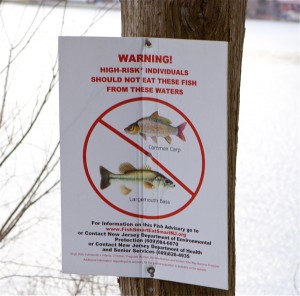
fish consumption warning posted on Pompton Lake
Mercury is highly toxic to humans, fish and wildlife – it bioaccumulates through the food chain. Its effects are magnified by predators up the food chain and persist for many years.
Like in the the Hudson River, because of mercury pollution, it is unsafe to eat freshwater fish in NJ – and consumption warnings are posted on Pompton Lake (but largely ignored).
Dupont wiped out an entire fishery.
And like Hudson River PCB’s, EPA has extensive national scientific and regulatory experience with mercury in the Great lakes region that is relevant to Dupont Pompton Lakes.
Like GE, Dupont wants to minimize the cost of cleanup and resists EPA cleanup mandates.
I don’t know about GE/Hudson, but in Pompton lakes, EPA Regional Administrator Judith Enck has given the community multiple assurances that EPA will hold Dupont accountable and strictly enforce environmental laws. For example, in an October 14, 2010 reply letter, RA Enck assured me that:
You have my commitment that the Environmental Protection Agency will ensure that Dupont will fulfill its RCRA obligations for this facility.
But Dupont has proposed a partial cleanup plan of just a 26 acre portion of the 250 acre Pompton Lake – no downriver sediment removal is being considered at this time. Dozens of areas of toxic soil contamination on the Dupont site still have not been cleaned up (after 30 years).
The plan is not only for only a small part of the Lake, but it is based on flawed science.
The Dupont plan must be approved by EPA under the Resource Conservation and Recovery Act (RCRA), the most important environmental law you probably never even heard of (and the polluters like it that way).
But now the Dupont plan is in EPA’s lap, which in some ways makes Dupont’s mercury problem EPA’s problem too.
Was Dupont’s plan reviewed and approved by EPA’s national scientific experts on mercury and USFWS scientists? Here’s why we need to know answers to those questions:
I) Florio Lets the Liability Cat Out of the Bag
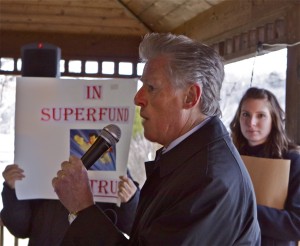
Jim Florio, sponsor of 1980 Superfund law, speaks at community rally (1/5/12)
The residents of Pompton Lakes want the site designated and cleaned up by EPA under the Superfund program.
Thus far, their primary reasons for wanting Superfund instead of RCRA is that Superfund would bring more federal resources, a higher priority and visibility, and more community involvement in cleanup decisions.
But Jim Florio, Former NJ Governor and original sponsor of the 1980 Superfund law, just let the legal liability cat out of the bag.
The Superfund liability scheme adds another very good reason to use Superfund to compel Dupont to conduct a comprehensive and complete cleanup of the entire site, Pompton Lake, and downriver and compensate the public for huge natural resource and ecological damages they have caused (just like GE in the Hudson).
Florio went out of his way to emphasize that under Superfund, the legal liability scheme is known as “strict, joint, and several”.
Practically, what this legalese essentially means is that:
- Dupont is 100% on the hook for the ENTIRE problem
- EPA does not have to prove negligence by Dupont
- EPA has enormous power to force Dupont to do a complete cleanup.
This is key because mercury pollution comes from multiple sources: coal power plants, garbage incinerators, and smelters and industrial sources.
Dupont is arguing that they are responsible ONLY for the mercury they allegedly contributed – and only via Acid Brook runoff, NOT THE TOTAL HISTORIC MERCURY AIR EMISSIONS FROM THE DUPONT PLANT AND ALL ON SITE DISPOSAL PRACTICES.
EPA has agreed to this bogus Dupont argument and that is why only a 6 inch deep small 26 acre portion of the 250 acre Lake (the “Acid Brook Delta”) sediments are being dredged.
Dupont could not get away with that under Superfund.
While it is true that EPA has less legal leverage under RCRA that Superfund, EPA still could do the right thing by forcing Dupont to scientifically establish how much mercury came from their facility and how much came from other sources.
But Dupont has not done any of that kind of work and EPA therefore has no scientific basis upon which to approve the plan. (and that’s just EPA’s problem #1)
II) Dupont’s Science is Flawed and Can Not Be Approved BY EPA
EPA has done an enormous amount of scientific work on mercury.
In contrast with this rigorous EPA body of work, Dupont’s various regulatory documents rely on cursory and flawed science and assessment methods.
These flawed Dupont approaches provide the basis for the Dupont partial Acid Brook Delta cleanup plan and ecological assessment.
Dupont’s science and methods are inconsistent with, do not meet the rigorous standards of, and contradict EPA science. [Update: See
As such, EPA can not approve of them by approving a cleanup plan based on them.
The primary EPA scientific sources for mercury, for our purposes are (there are lots others):
(examples of additional studies of scientific and regulatory relevance are the
Compared with the EPA Recommendations to Congress on ecologically protective mercury fish tissue levels, fish in Pompton lakes contain 2 – 10 TIMES safe levels.
Depending on trophic level of the fish, the EPA finding is 0.077 ppm – 0.346 ppm.
According to DEP, the fish in Pompton Lake average 0.72 ug/g (ppm).
[Update: A May 6, 2008 DEP email to Dupont specifically addressed this issue:
in order to present a balanced comparison, DuPont shall compare the average concentrations of mercury in largemouth bass from Pompton Lake to the regional average of 0.46 ug/g mercury in largemouth bass and/or the statewide average (0.44 ug/g) in the Remedial Investigation Report.
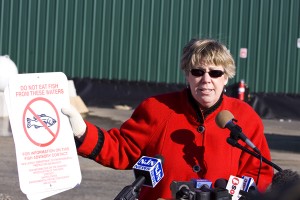
Judith Enck, EPA region 2 Administrator came to NJ to warns residents about risks of eating contaminated fish from waters nearby toxic sites
Additionally, Dupont’s ecological risk analysis is flawed, as it relies too heavily on alleged no impacts on the benthic (bottom) macroinvertebrate community structure. Community structure is a poor indicator of bioavailability, bioaccumulation, and ecological risk that I haven’t seen used anywhere else. And even if you were looking at macro invertebrates, you would be doing so to consider food chain bioaccumulation, so you would look at tissue concentration of mercury, not community structure.
[Update: I may have misread the Dupont documents on this point – macro-invertibrate community structure is of relevance, and YOY fish are trophic indicator in food web design – see Mercury Cycling in Stream Ecosystems. 3. Trophic Dynamics and Methylmercury Bioaccumulation – Where Dupont draws misleading conclusion is with this assertion:
However, tissue concentrations measured in the delta in 2005 do not indicate an increased accumulation of mercury by chironomids and YOY fish tissue relative to the tissue data collected during the 1998 ecological investigation. – end update]
[Update 2 – Here is what I meant to say, as provided by DEP’s Ecological Evaluation Guidance says about limitations of macro invertebrate sampling:
Some limitations are that they do not identify the contaminant responsible for the observed toxicity, population impacts are not readily translated into contaminant remediation goals, and results are often confounded by variables not related to contaminant toxicity (predation, seasonal differences, physicochemical sediment characteristics, food availability).]
Similarly, Dupont sampled “young of year” (YOY) fish, which minimizes bioaccumulation as young fish haven’t lived long enough to bioaccumulate the mercury in the system.
Here are additional serious flaws in Dupont’s analysis:
1) I didn’t see anything in Dupont’s documents concerning terrestrial mammals
2) There was no data or discussion of the bird sampling – other than a cursory claim of low/no adverse impact on 4 of 5 bird species sampled. What bird species? What tissue (or egg shell) concentrations found? What adverse impacts were considered?
3) There was no discussion of biological mechanisms that convert mercury they propose to leave in the sediments into bioavailable forms.
4) There was no data provided or consideration given to Dupont’s historic use of mercury compounds in manufacture.
5) There was no data or estimate of Dupont’s mercury air emissions and how those emissions deposited locally.
6) There was no dating or chemical analysis of soil or sediment cores that would suggest historic patterns of mercury deposition.
7) The full extent of mercury deposition and off-site release from the Dupont facility has not be adequately characterized.
8) There was no valid characterization of “mercury background”.
[According to the USEPA, background refers to constituents that are not influenced by the discharges from a site, and is usually described as naturally occurring or anthropogenic (USEPA, 2002a). U.S. Environmental Protection Agency (USEPA). 2002a. “Role of Background in the CERCLA Cleanup Program.” Office of Solid Waste and Emergency Response.
[ According to NJ DEP Ecological Evaluation Guidance:
Background area samples should be collected from an area outside the site’s potential influence and not in locations directly influenced by or in proximity to other obvious sources of contamination.
9) There was no data provided to support apportionment of mercury in the environment as Dupont alleges to minimize their cleanup obligations (i.e. Dupont share and other source share).
10) There was no data or estimate sof total mercury loading; mechanisms and estimates of methylation; fate/transport modeling; bioaccumulation mechanisms; and human and wildlife exposure and risk assessments from air emissions, contaminated soil, surface water runoff of mercury disposed on site.
I assume that some of this data and analysis were provided in the original ecological assessment submitted to NJ DEP in accordance with State cleanup regulations (and rubber stamped by DEP’s broken cleanup program).
[Full disclosure Update: in 1995, a former NJ Governor, with DEP’s help, was shown to misrepresent the science on mercury in fish tissue to downplay risks – when I disclosed this scheme, management retaliated and I was forced out of DEP as a whistle-blower. Hit that link for all the documentation.]
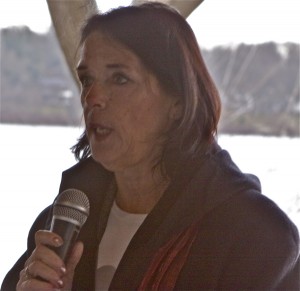
Lois Gibbs speaks at community rally (1/5/12)
However, this is an EPA federal RCRA action that must be EPA approved. Accordingly, all the documents must be made available to the public during the comment period. That has not been done in this case so EPA can not approve the Dupont plan based on documents and analyses that have not been made publicly available.
III) EPA is Required to Consult with US Fish and Wildlife Service
RCRA regulations require EPA to consult with federal agencies, including the US Fish and Wildlife Service during the RCRA permit process.
We advised EPA Regional Administrator Enck on November 17, 2011 that RCRA regulations include full federal partner review including, but not limited to, U.S. Fish and Wildlife Service, National Oceanic and Atmospheric Administration, and Agency for Toxic Substance and Disease Registry, pursuant to regulation 40 CFR 124.10(c)(iii).
Certainly such consultation is required BEFORE EPA issues a “tentative approval” and proposes a draft RCRA permit for public comment.
Thus far, it appears that EPA has not complied with these consultation requirements prior to issuing the draft permit.
IV) Dupont is Required to Comply with Clean Water Act Standards
The federal Clean Water Act applies to Dupont’s water pollution discharges.
The CWA also applies to the RCRA permit process, which must meet CWA requirements.
NJ DEP State surface water quality standards (SWQS) have been approved by EPA and are federally enforceable. They trigger enforceable requirements on pollution discharge that may “cause or contribute to” a violation of a SWQS.
NJ DEP SWQS designate Pompton Lake for recreational use (fishing, swimming,etc), aquatic life protections, and water supply.
The SWQS have policies and narrative and numeric standards that the RCRA permit and Dupont clean up must comply with.
The Dupont proposed cleanup plan provides no discussion or demonstration regarding compliance with the legally applicable and binding provisions of the CWA or NJ SWQS.
Accordingly, EPA can not approve the Dupont proposal as a final RCRA permit in the absence of this compliance demonstration.
EPA must stand by their own science. According to the EPA supported NJ DEP wildlife criteria proposal. According to the DEP SWQS proposal (which USFWS and EPA supported)::
“As part of the 1994 approval of the New Jersey SWQS triennial review process, the USEPA, in collaboration with the USFWS, indicated that the human health based criteria for PCBs were not protective of the threatened and endangered species bald eagle, peregrine falcon, and dwarf wedgemussel. As a result, the Service prepared a Biological Opinion document in 1996 (Biological opinion on the effects of the U.S. Environmental Protection Agency’s approval of the state of New Jersey’s surface water quality standards on the bald eagle, peregrine falcon, and dwarf wedgemussel. U.S. Department of the Interior, Fish & Wildlife Service, New Jersey Field Office, Pleasantville, New Jersey. 1996). The lack of wildlife criteria for DDT and its metabolites, mercury, and PCBs was a concern to the USFWS. DDT and its metabolites, mercury, and PCBs are bioaccumulative pollutants that are persistent in the environment, accumulate in biological tissues, and biomagnify in the food chain. Due to these characteristics, the concentration of these contaminants may increase as they are transferred up through various food chain levels. As a result, adverse impacts to non-aquatic, piscivorous (fish-eating) organisms may arise from low surface water concentrations. The peregrine falcon is not a piscivorous species. However, it feeds on other piscivorous bird species. Therefore, biomagnification may be of even greater concern for the peregrine falcon.
The USEPA developed site-specific wildlife criteria for the Great Lakes based on a number of factors, including the toxicity of various pollutants and their tendency to bioaccumulate and biomagnify. In addition, the USEPA gathered and applied information about piscivorous wildlife endemic to the Great Lakes region in its derivation of water quality criteria. That effort resulted in the promulgation of numeric surface water concentrations designed to be protective of all avian and mammalian wildlife using Great Lakes waters. “
EPA must now stand by Regional Administrator Enck’s commitment and their own science and reject the Dupont proposal.
1) Dupont’s proposed cleanup of Acid Brook Delta is only partial – we demand that all mercury and all pollutants be completely and permanently cleaned up so that the Lake is fishable and swimmable as mandated by the federal Clean Water Act and NJ Water Pollution Control Act;
2) The original 1992 EPA issued RCRA permit must be enforced and has numerous loopholes that must be closed – all RCRA “SWMU’s” and off site releases which are sources of toxic soil, sediment, vapor, and groundwater contamination must be cleaned up under more aggressive schedules and obligations than those EPA unilaterally imposed in a “compliance schedule modification” on May 4, 2010 without public notice and comment;
3) Natural resource damages and toxic fish and wildlife impacts of Dupont’s pollution have not been assessed fully and must be assessed and the public fully compensated;
4) EPA must take enforcement action and collect fines such that vapor mitigation systems are immediately installed in all impacted homes.
The plume area may be larger than currently thought, when subsurface infrastructure migration is considered.

Rally before EPA RCRA permit hearing (1/5/12)



















